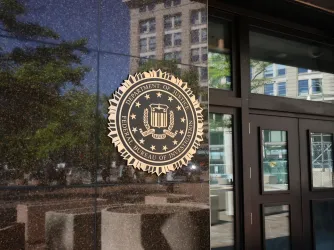Table of Contents
Hamline University president triples down in defending instructor’s nonrenewal for showing Muhammad painting

Shutterstock.com
Hamline University President Fayneese S. Miller
Ignoring the first law of holes, Hamline University President Fayneese S. Miller issued a new statement defending the university’s nonrenewal of art history adjunct lecturer Erika López Prater because of her in-class display of artwork depicting the Islamic prophet Muhammad.
You can, and should, read President Miller’s internally inconsistent statement below.
Miller opens by asserting that López Prater was not “let go,” “dismissed,” or “fired,” and had not “lost her job,” because a lower-level “unit” made a “decision not to offer her another class” — a decision, Miller says, which “in no way reflects on [López Prater’s] ability to adequately teach the class.” Having explained that the lecturer was not terminated, Miller explains that they were right to let her go, as Hamline University’s steadfast commitment to academic freedom is subordinate to the “traditions, beliefs, and views of students,” the “dictates of society,” and unidentified “laws.”
Miller asserts:
Prioritizing the well-being of our students does not in any way negate or minimize the rights and privileges assured by academic freedom. But the concepts do intersect. Faculty have the right to teach and research subjects of importance to them, and to publish their work under the purview of their peers.
At the same time, academic freedom does not operate in a vacuum. It is subject to the dictates of society and the laws governing certain types of behavior.
Citing an op-ed critiquing academic freedom as a principle that “can be manipulated” and “become a weapon to be used against vulnerable populations,” and the American Federation of Teachers’ anodyne observation that academic freedom isn’t a license to behave unprofessionally, Miller continues:
I ask those who presume to judge us the following questions: First, does your defense of academic freedom infringe upon the rights of students in violation of the very principles you defend? Second, does the claim that academic freedom is sacrosanct, and owes no debt to the traditions, beliefs, and views of students, comprise a privileged reaction? That is why Hamline’s Civility Statement, which guards our campus interactions, notes that any student, regardless of race, ethnic background, religion or belief, deserves equal protection from the institution.
A statement laying out such a deeply flawed understanding of academic freedom would be confounding if it came from the president of any college or university, but it is all the more so when it comes from a leader weeks into a controversy over academic freedom.
Where to begin?
First, far from being subordinate to “the dictates of society,” academic freedom is a bulwark against society’s “dictates.” It is intended to give faculty breathing room to explore ideas and materials others think should not be aired. Those pressures may come from administrators, lawmakers, donors, community leaders, parents, or students whose “traditions, beliefs, [or] views” animate their objections to the discussion or material.
If a professor’s expression is popular with society, she wouldn’t need the shield of academic freedom. The “dictates of society” are the pressure to be resisted — not implemented — by a university’s leaders.
Universities cannot use the contingent status of untenured faculty as a basis to depart from their commitment to academic freedom.
Second, Miller invokes “the law” and Hamline’s “Civility Statement” as limiting academic freedom, implying that López Prater must have exceeded those limits. But Miller’s vague invocation of “the law” is incorrect. No law requires, much less justifies, Hamline’s incursion into López Prater’s class.
Contrast Miller’s characterization of the university’s “Civility Statement” (“which guards our campus interactions, notes that any student . . . deserves equal protection from the institution”) with what it actually says, with emphasis added:
Hamline University is dedicated to intellectual inquiry in its full depth, breadth, abundance, and diversity. It is committed to academic freedom and celebrates free expression for everyone. The University embraces the examination of all ideas, some of which will potentially be unpopular and unsettling, as an integral and robust component of intellectual inquiry. It is expected that the expression of ideas will be done in ways that are respectful of others and which do not include personal vilification based on race, ethnicity, religion, gender, sexual orientation, sexual identity, appearance, disability or political affiliation. Hamline University encourages all, whether it be on campus or off, to foster a respectful, and inclusive community defined by a concern for the common good, by developing relationships and through a culture that promotes the rights, safety, dignity, and value of every individual. A university community embracing these common values, consisting of students, faculty, staff, the Board of Trustees, and external constituents, is vital to the pursuit of excellence in research, scholarship, and creative activity.
Miller’s statement lacks any indication López Prater engaged in any such “personal vilification” or discriminatory conduct. To the contrary, López Prater anticipated that some students’ religious beliefs may preclude them from viewing the artwork. In her syllabus, she sought to “affirm students of all religious observances and beliefs in the content of the course,” noting that she would “introduce students to several religious traditions and the visual cultures they have produced historically,” including “showing and discussing both representational and non-representational depictions of holy leaders (for example, the Prophet Muhammad, Jesus Christ, and the Buddah).” She urged students with “questions or concerns about either missing class for a religious observance or the visual content that will be presented” to contact her.

Hamline hiding critical Twitter, Facebook posts amid blasphemy ban controversy
The Prophet Muhammad isn’t the only thing the university doesn’t want you to see.
That’s not what “personal vilification” looks like.
Third, Miller’s pedantic complaint that López Prater wasn’t “fired” because Hamline chose not to renew her contract misses the point entirely. While an institution can decide not to renew a contract for a good reason, an unwise reason, or no reason at all, it cannot decide to do so for an unlawful or inappropriate reason. Hamline University’s commitments, in its policies and accreditation requirements, to protect academic freedom prohibit the university from basing a faculty member’s nonrenewal on her exercise of the very rights Hamline says it protects.
Universities cannot use the contingent status of untenured faculty as a basis to depart from their commitment to academic freedom. Faculty without tenure can only rely on a university’s willingness to abide by its commitment to academic freedom, or academic freedom will belong only to those with tenure.
If, as Miller asserts, it is important that Hamline University steadfastly adhere to the commitment it makes in its Civility Statement, FIRE strongly agrees. When Hamline promises the full breadth of academic freedom, even if it is “unpopular and unsettling” to students, it must keep that promise. Hamline University’s treatment of López Prater does not comport with that commitment.
President Fayneese S. Miller’s January 11, 2023, Statement
Here is President Miller’s statement in full. We’ve added links to the articles and policies she references:
My institution, Hamline University, a small liberal arts college located in St Paul, Minnesota, has been in the news lately. The New York Times ran an article leading with the headline, “Prophet Image Shown in Class, Fraying the Campus.”
The article reports on an incident that occurred on our campus in October, where an adjunct instructor, teaching a class in art history, showed an image of the prophet Muhammad to a class attended by a number of Muslim students. And when a Muslim student objected to its showing, to quote the Times, the adjunct “lost her job.”
Various so-called stakeholders interpreted the incident, as reported in various media, as one of “academic freedom.” The Times went so far as to cite PEN America’s claim that what was happening on our campus was one of the “most egregious violations of academic freedom” it had ever encountered.
It begs the question, “How?” Because Hamline University is now under attack from forces outside our campus, I am taking this opportunity to comment upon, and in several important instances, correct the record regarding critical aspects of this incident -- both as reported in the press, and as shared by those who have been enjoined in the conversation about academic freedom.
First, I must state that the adjunct instructor hired to teach the course in art history did not “lose her job,” as has been reported by some outlets. Neither was she “let go” nor “dismissed,” as has also been reported. And most emphatically, she has not been “fired,” as has also been claimed.
The adjunct taught the class to the end of the term, when she, like all other faculty, completed the term requirements, and posted her grades. The decision not to offer her another class was made at the unit level and in no way reflects on her ability to adequately teach the class.
However, media coverage of the [sic] characterized the aftermath differently: reports were that the adjunct instructor was “dismissed” or “fired.” Fueled by commentary not well-informed on the particulars of this situation, we now find ourselves at the heart of a purported stand-off between academic freedom and equity. It has escalated to the point where I, members of my executive staff, other campus staff and, most sadly, one of our students now receive daily threats of violence.
To suggest that the university does not respect academic freedom is absurd on its face. Hamline is a liberal arts institution, the oldest in Minnesota, the first to admit women, and now led by a woman of color. To deny the precepts upon which academic freedom is based would be to undermine our foundational principles.
Prioritizing the well-being of our students does not in any way negate or minimize the rights and privileges assured by academic freedom. But the concepts do intersect. Faculty have the right to teach and research subjects of importance to them, and to publish their work under the purview of their peers.
At the same time, academic freedom does not operate in a vacuum. It is subject to the dictates of society and the laws governing certain types of behavior. Imara Scott, in an April 2022 article published in Inside Higher Ed, noted that “academic freedom, like so many ideological principles, can be manipulated, misunderstood, and misrepresented…academic freedom can become a weapon to be used against vulnerable populations. Why? Because on the other end of a professor claiming academic freedom may be a student — a student who lacks tenure, who must rely on that professor for a grade and who may be emotionally, intellectually, or professionally harmed by the professor’s exercise of the power they hold.”
Also, the American Federation of Teachers correctly notes that “academic freedom and its attendant rights do not mean that ‘anything goes’”. It notes that “faculty must act professionally in their scholarly research, their teaching, and their interactions with students and…ensure this through policies and procedures that safeguard both students and the academic integrity of the institutions and disciplines”.
I ask those who presume to judge us the following questions: First, does your defense of academic freedom infringe upon the rights of students in violation of the very principles you defend? Second, does the claim that academic freedom is sacrosanct, and owes no debt to the traditions, beliefs, and views of students, comprise a privileged reaction? That is why Hamline’s Civility Statement, which guards our campus interactions, notes that any student, regardless of race, ethnic background, religion or belief, deserves equal protection from the institution.
It is far easier to criticize, from the security of our computer screens, than it is to have to make the hard decisions that serve the interests of the entire campus community. What disappoints me the most is that little has been said regarding the needs and concerns of our students that all members of our community hold in trust. I hope this changes.
I also note that Hamline is an independent university still closely affiliated with the United Methodist Church, and its foundational principles inscribed in the oft-repeated words on our campus of John Wesley: “To do all the good you can, by all the means you can, in all the ways you can, in all the places you can, at all the times you can, to all the people you can, as long as ever you can.” We at Hamline live by these words.
To do all the good you can means, in part, minimizing harm. That is what has informed our decisions thus far and will continue to inform them in the future. We hope you understand and respect the values guiding our efforts.
Sincerely,
Fayneese Miller, PhD
President
FIRE defends the rights of students and faculty members — no matter their views — at public and private universities and colleges in the United States. If you are a student or a faculty member facing investigation or punishment for your speech, submit your case to FIRE today. If you’re faculty member at a public college or university, call the Faculty Legal Defense Fund 24-hour hotline at 254-500-FLDF (3533).
Recent Articles
Get the latest free speech news and analysis from FIRE.

VICTORY: Court vindicates professor investigated for parodying university’s ‘land acknowledgment’ on syllabus

Can the government ban controversial public holiday displays?

DOJ plan to target ‘domestic terrorists’ risks chilling speech


